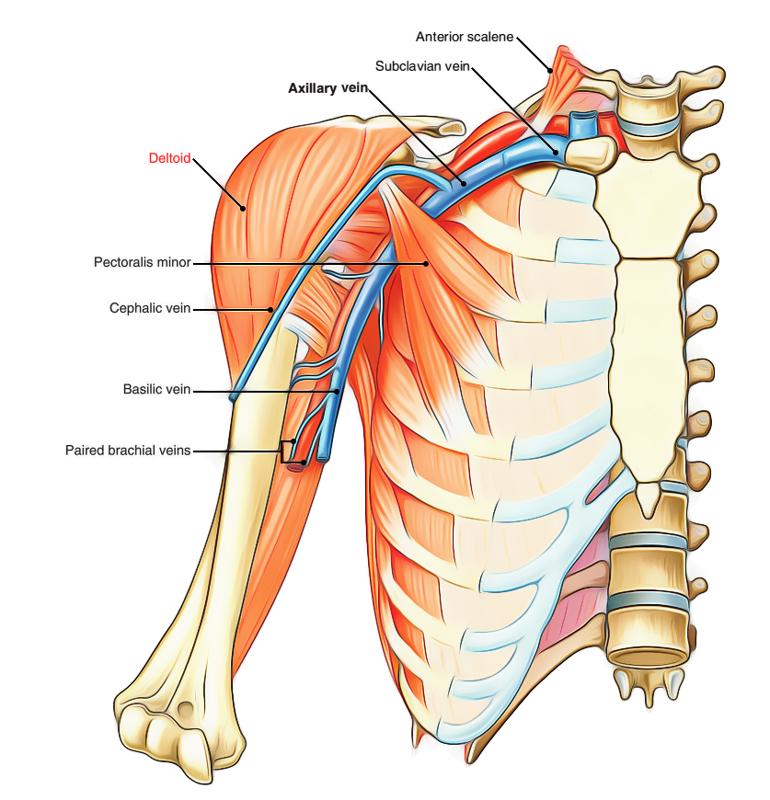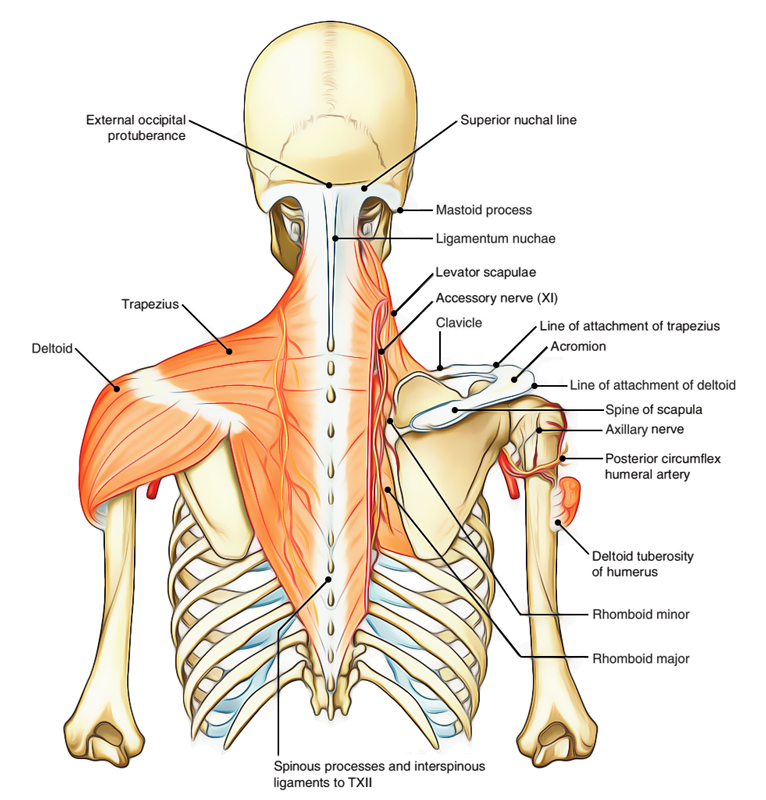The Deltoid is a three-in-one muscle. It’s thick, powerful, and curved triangular muscle covering the shoulder and creating its rounded contour. The deltoid is shaped like the inverted Greek letter Delta (D), for this reason its name deltoid. The deltoid muscle is split into 3 parts:
- Anterior unipennate part.
- Posterior unipennate part.
- Middle multipennate part.

Deltoid
Origin
The deltoid has a V-sheiped origin from the subcutaneous bony arch created by
(a) lateral one-third of clavicle
(b) acromion process
(c) crest of spine of the scapula. The details are as under:
- The anterior unipennate part—arises from the upper surface and anterior border of the lateral third of the clavicle
- The middle multipennate part—arises from the lateral margin and upper surface of the acromion
- The posterior unipennate part—arises from the lower lip of the crest of the spine of the scapula
Insertion
- The fibres converge inferiorly to create a short thick tendon, that is inserted onto the V-shaped deltoid tuberosity/ tubercle on the lateral aspect of the midshaft of the humerus.
- The fibres of multipennate middle part originate from 4 septa which are connected above to the acromion. These fibres converge onto the 3 septa of insertion, that are connected to the deltoid tuberosity. Because of multipennate arrangement, the middle acromial part of the deltoid is the strongest part.
Nerve Supply
The deltoid is supplied by the axillary nerve (C5 and C6).
Actions
- The anterior (clavicular) fibres are flexors and medial rotators of the arm.
- The posterior (spinous) fibres are the extensors and lateral rotators of the arm.
- The middle (acromial) fibres are the strong abductor of the arm from 15° to 90°. Middle (acromial) fibres cannot abduct the arm from 0° to 15° when the arm is by the side of body because its vertical pull corresponds to the long axis of the arm.
The deltoid muscle is like 3 muscles in 1: the anterior fibres flex the arm, lateral fibres abduct the arm and posterior fibres extend the arm.
Functions
Standard Mover Actions
- Abducts the arm at the glenohumeral joint (entire muscle).
- Flexes the arm at the glenohumeral joint (anterior deltoid).
- Medially rotates the arm at the glenohumeral joint (anterior deltoid).
- Horizontally flexes the arm at the glenohumeral joint (anterior deltoid).
- Extends the arm at the glenohumeral joint (posterior deltoid).
- Laterally rotates the arm at the glenohumeral joint (posterior deltoid).
- Horizontally extends the arm at the glenohumeral joint (posterior deltoid).
Reverse Mover Actions
- Downwardly rotates the scapula at the GH and scapulocostal joints.
- Ipsilaterally rotates the trunk.
- Contralaterally rotates the trunk.
Clinical Testing
The deltoid can be easily viewed and felt to contract when the arm is abducted against resistance.
Clinical Significance
- Site of the intramuscular injection in deltoid: The intramuscular injections are commonly supplied in the lower half of the deltoid to avoid injury to the axillary nerve, which winds around the surgical neck of the humerus.
- In actual clinical practice, the intramuscular injection is supplied in the upper and outer quadrant of the deltoid region.
Structures Under Deltoid

Structures Under Deltoid
- Bones: Upper end of the humerus and coracoid process.
- Joints and ligaments: Shoulder (glenohumeral) joint and coracoacromial ligament.
- Bursae around the shoulder joint: Subscapular, subacromial/ subdeltoid, and infraspinatus.
- Muscles:
- Insertions of pectoralis minor, pectoralis major, teres major, latissimus dorsi, subscapularis, supraspinatus, infraspinatus, and teres minor.
- Origins of long head of biceps, short head of biceps, coracobrachialis, long and lateral heads of triceps.
- Vessels: Anterior and posterior circumflex humeral.
- Nerves: Axillary nerve.
- Spaces: Quadrangular and triangular subscapular intermuscular spaces.
Palpation
- With the client seated, place palpating hand just distal to the acromion process of the scapula.
- Have the client abduct the arm at the glenohumeral joint and feel for the contraction of the deltoid. Resistance can be added.
- Continue palpating the deltoid anteriorly for the anterior fibers and posteriorly for the posterior fibers. Palpate all fibers distally to the deltoid tuberosity of the humerus.
- Note: Horizontal flexion can be used for the anterior fibers; horizontal extension can be used for the posterior fibers.

 (58 votes, average: 4.84 out of 5)
(58 votes, average: 4.84 out of 5)